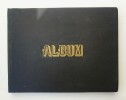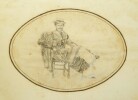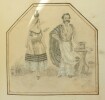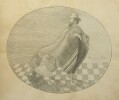[ALBUM DE DESSINS ARGENTINE/ALBUM OF DRAWINGS ARGENTINA]
[Ensemble de 40 dessins au crayon noir ou à l'encre, certains rehaussés d'aquarelle/Set of 40 drawings in black pencil or ink, some enhanced with watercolor].
S.l., 1858-1864 (pour la plupart) 1858 1 vol in-4° oblong (225 x 300 mm.) de: 35 ff. de dessins (les 6 derniers sur papier teinté); 3 ff. manuscrits ajoutés. Demi-chagrin noir d'époque, dos lisse orné en long d'un motif doré, titre doré « Album » sur le premier plat, tranches dorées.
Reference : 5533
Magnifique album comprenant 40 dessins au crayon noir ou à l'encre (certains rehaussés à laquarelle) sur lArgentine du milieu du XIXe siècle. La plupart sont daté de 1858-1864 mais ne présentent pas de lieu spécifique. Les dessins, montés sur les feuillets de l'album ou exécutés à pleine page, montrent des portraits de Gauchos, ou gardiens de troupeaux des plaines sud-américaines, des personnages divers, des scènes allégoriques, des militaires, des cavaliers à la chasse, des vues d'une baie et de quelques îlots, ainsi que des installations minières en Argentine. Parmi cet ensemble, 5 dessins sont signés « P.A. Conil » ou « P.A.C », 1 est signé « Emilie Jaudin » et un autre « Rosenthal » ; les autres ne sont pas signés. On relève une quinzaine de dessins évoquant principalement l'Argentine : Gaucho assis, de profil (signé P.A. Conil). - Gaucho argentin représenté assis, de trois-quarts. - Roue del Ojo de Agua (daté 16 janvier 1858). - Gaucho argentin, représenté de face, portant un éperon à une botte. - Plan du Guayco (encre et aquarelle). - Gaucho argentin debout, vu de face. - Portrait d'homme, vu de profil (daté 15 mars 1858). - Gauchos paraguayes (signé P.A. Conil ; il représente un gaucho et une gaucha). - Portrait d'un habitant en costume (daté 27 juillet 1860). - Faena de la Mina Eufemia (crayon noir, encre et rehauts d'aquarelle). - Mina Eufemia (encre et aquarelle, 4 coupes sur double page datées 1861 à 1864). - Casa y Despensas de la Mina Eufemia (encre et aquarelle). - Cerro de la Yba Buena (croquis de cette montagne, avec mention « visité le 15 janvier 1858 avec MM. Lelong, Martin de Moussy, Shaw, Léon Roque »). - Gauchos regardant un combat de coqs (signé P.A. Conil). - Vue d'une baie bordée de montagnes. - Vue de plusieurs îlots (avec 3 petits dessins à l'encre, au lavis ou au crayon). L'auteur devait probablement être employé dans l'une des mines représentées dans l'album, celles-ci étant situées dans la province de Córdoba, au nord de l'Argentine. L'un des feuillets manuscrits précise : « Les mines de la Société A. Barrau & P. Jaudin sont au nombre de neuf dont huit dans le district minier du Guayco et une dans celui de l'Ojo de Agua. Le Guayco est à une distance de six lieues environ de l'établissement de fonderie ; il en est séparé par un chemin qu'il serait facile, à peu de frais, de rendre carrossable... ». Suit la liste des mines en question, elle-même suivie d'un tableau synoptique des mines exploitables d'où étaient extraits les minerais de plomb et d'argent. A la fin, un dessin représente un village à proximité d'un cours d'eau; exécuté à la plume et à l'encre noire, il est daté et signé « 04 P.A.C ». Un autre dessin, également à l'encre, représente une carte des environs de Sainte-Foy (Dordogne) ; il est signé et daté « P.A. Conil 1907 ». Ces deux dessins semblent être de Pierre-Auguste Conil, mort en 1942, préhistorien et archéologue, vice-président de la Société historique et archéologique de Libourne, auteur de nombreux travaux sur la préhistoire et les antiquités gallo-romaines. Quant aux dessins exécutés vers 1860, ils ont sans doute été réalisés par un parent de Pierre-Auguste Conil établi en Argentine et portant les mêmes initiales. L'un des dessins atteste qu'il a effectué une excursion avec le célèbre médecin et géographe Victor Martin de Moussy, qui explora l'Argentine, le Chili et le Paraguay de 1855 à 1859. Curieux album évoquant les mines en Argentine au milieu du XIXe siècle. 1 vol. 4-to oblong (225 x 300 mm.) of : 35 ff. of drawings (the last 6 on tinted paper); 3 ff. added manuscripts. Contemporary black half-chagrin, smooth spine decorated with a gilt motif, gilt title "Album" on the first board, gilt edges. Magnificent album including 40 drawings in black pencil or ink (some enhanced with watercolor) on Argentina in the mid-nineteenth century. Most of them are dated 1858-1864 but do not show a specific place. The drawings, mounted on the album leaves or executed full page, show portraits of Gauchos, or herdsmen of the South American plains, various characters, allegorical scenes, military men, horsemen hunting, views of a bay and some islets, as well as mining installations in Argentina. Among this set, 5 drawings are signed "P.A. Conil" or "P.A.C", 1 is signed "Emilie Jaudin" and another "Rosenthal"; the others are not signed. There are about fifteen drawings mainly evoking Argentina: Gaucho sitting, in profile (signed P.A. Conil). - Argentinean Gaucho represented seated, three-quarters. - Wheel of the Ojo de Agua (dated January 16, 1858). - Argentinean Gaucho, depicted in front, wearing a spur to a boot. - Map of Guayco (ink and watercolor). - Argentine Gaucho standing, seen from the front. - Portrait of man, seen in profile (dated March 15, 1858). - Paraguayan Gauchos (signed P.A. Conil; depicts a gaucho and a gaucha). - Portrait of an inhabitant in costume (dated July 27, 1860). - Faena de la Mina Eufemia (black pencil, ink and watercolor highlights). - Mina Eufemia (ink and watercolor, 4 cuts on double page dated 1861 to 1864). - Casa y Despensas de la Mina Eufemia (ink and watercolor). - Cerro de la Yba Buena (sketch of this mountain, with the mention "visited on January 15, 1858 with MM. Lelong, Martin de Moussy, Shaw, Léon Roque"). - Gauchos watching a cockfight (signed P.A. Conil). - View of a bay bordered by mountains. - View of several islets (with 3 small drawings in ink, wash or pencil). The author was probably employed in one of the mines represented in the album, these being located in the province of Córdoba, in the north of Argentina. One of the handwritten pages states: "The mines of the Company A. Barrau & P. Jaudin are nine in number, eight of which are in the mining district of Guayco and one in that of Ojo de Agua. The Guayco is at a distance of about six leagues from the smelter establishment; it is separated from it by a road that it would be easy, at little cost, to make passable..." (translated from French). This is followed by a list of the mines in question, itself followed by a synoptic table of the exploitable mines from which the lead and silver ores were extracted. At the end, a drawing depicts a village near a river; executed in pen and black ink, it is dated and signed "04 P.A.C". Another drawing, also in ink, represents a map of the surroundings of Sainte-Foy (Dordogne); it is signed and dated "P.A. Conil 1907". These two drawings seem to be by Pierre-Auguste Conil, who died in 1942, prehistorian and archaeologist, vice-president of the Historical and Archaeological Society of Libourne, author of numerous works on prehistory and Gallo-Roman antiquities. As for the drawings made around 1860, they were probably made by a relative of Pierre-Auguste Conil established in Argentina and bearing the same initials. One of the drawings shows that he went on an excursion with the famous doctor and geographer Victor Martin de Moussy, who explored Argentina, Chile and Paraguay from 1855 to 1859. Curious album evoking the mines in Argentina in the middle of the 19th century.
Bookseller's contact details
J-F Letenneur Livres Rares
M. Jean-François Letenneur
11 bd du tertre Gondan
35800 Saint Briac sur Mer
France
librairie@jfletenneurlivresrares.fr
06 81 35 73 35
 Write to the booksellers
Write to the booksellers





